Distribution and stabilization of bismuth NIR centers in Bi-doped aluminosilicate laser glasses by managing glass network structure
Abstract
Due to their super broadband near-infrared (NIR) emissions covering the low-loss window of silica, which rare earth ions cannot effectively cover, bismuth (Bi)-doped glasses have aroused increasing interest for developing a new generation of fiber lasers and optical amplifiers. However, there is no strategy to stabilize Bi NIR emission centers (BNECs) as far as we know. Herein, we propose a local excess charge model to stabilize or destabilize these centers within the glass network; this is verified by a model glass system of La2O3–Al2O3–SiO2 by properly managing the glass structure. Statistical excess charge field around Bi can be built up by either introduction of glass modifier or substitution of silicon by different glass former ions with a valence state not equal to +4 in silicate glass. Addition of glass modifier La3+, as revealed by 27Al MAS NMR, 29Si MAS NMR, and FT-IR spectra, breaks down Si–O–Si bonds and creates non-bridging oxygens (NBOs). The content of NBOs increases as La3+ concentration increases, and the excess negative charges are therefore produced, forcing the conversion of the valence state of partial Bi to a higher valence state for electroneutrality. As a result, the content of BNECs decreases, according to the absorption spectra; meanwhile, the NIR emission shifts to 1220 from 1140 nm along with a monotonous reduction in lifetime. This is perhaps due to the enhanced asymmetric stretching vibration of Si–O− and consequently the enhanced crystal field around Bi as well as the rearrangement of glass network and redistribution of Bi within it after breakdown of Si–O–Si bonds. Substitution of Al3+ for Si4+ can produce similar excess negative charges in the neighbourhood of Bi but in a way completely different from the introduction of La3+. Slight changes in the glass structure are observed, as proved by 27Al and 29Si MAS NMR and FT-IR spectra and in turn, the peak wavelength and lifetime of Bi emission show almost no changes although the emission intensity decreases as Al3+ content increases due to the decreasing content of BNECs. This study solves the problem of stabilizing BNECs in glasses, and it can be helpful for designing Bi-doped laser glasses with stable luminescent properties and for the fabrication of fibers in future.

- This article is part of the themed collection: 2018 Journal of Materials Chemistry C HOT Papers


 Please wait while we load your content...
Please wait while we load your content...